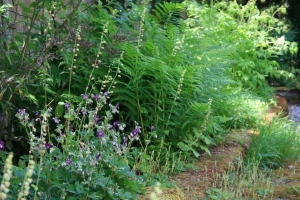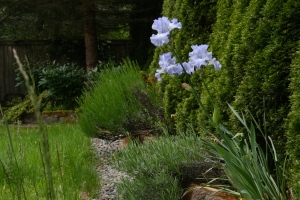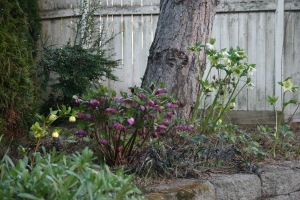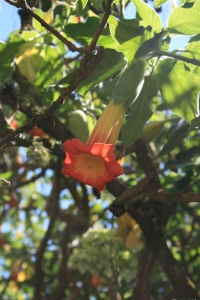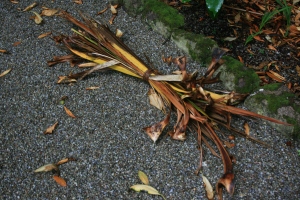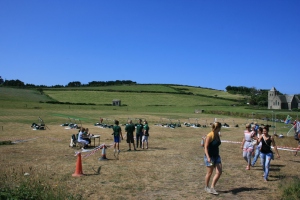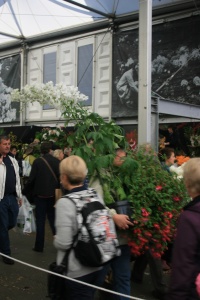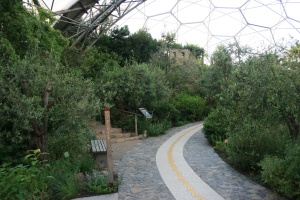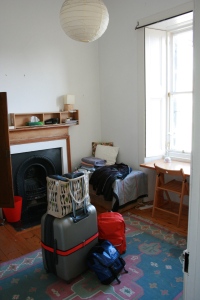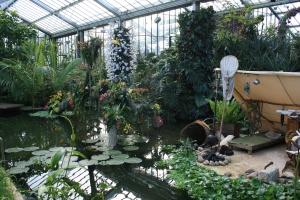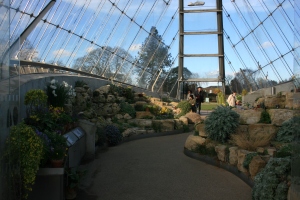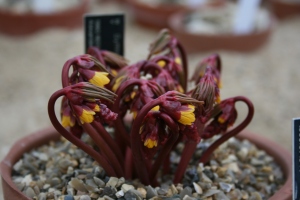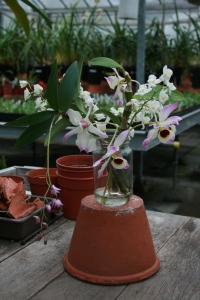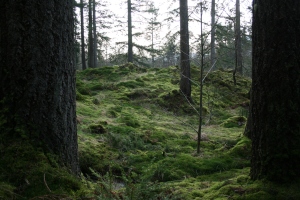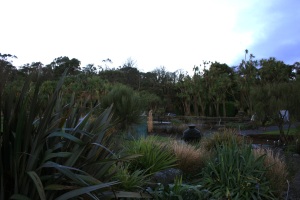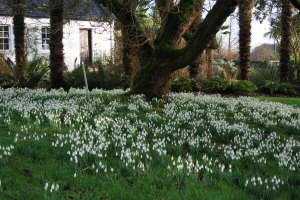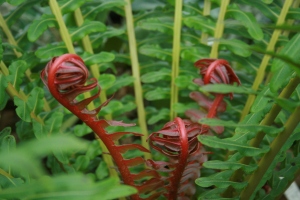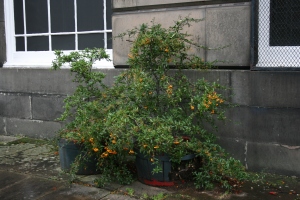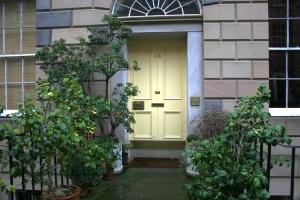Has it really been almost a month since I last wrote? My goodness! Well, since my last post I’ve been working in the Tropical Nursery for three weeks. Each week was with a different section starting with Arid, then Temperate, and my final week with the Orchids. (There is also Moist and Bromeliads, but I was unable to work in those zone.)
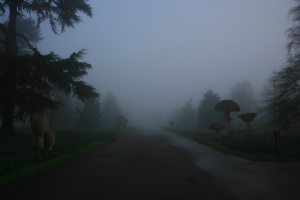
The mist that shrouded RBG, Kew this morning was particularly ominous.
Each section is further divided up into zones where the whole range of zones can accommodate plant species from cooler regions all the way to the most tropical. Working in the Tropical Nursery was like slipping through the looking glass and into Wonderland – everything from the rarest plants on earth to the wackiest ones that only nature could have dreamt lived in these glasshouses.

This is one part of the aloe collection.
My tasks mainly included repotting, grooming, and watering the collections, but whenever I had the chance I relished exploring the different zones and finding gems from the sublime to the ridiculous.

This is the most tropical zone in the Tropical Nursery and sometimes when I poke around in here I almost forget I am in England.
Though I wish I could share all the wonderful plants here, there is really too many to be able to include in one single post. So there will be a smattering of botanically delectable morsels.

These young Passiflora cuttings are putting on lush growth and soon will be moved to their more permanent places.
First let’s start with Pelargonium appendiculatum. I spied this little cutie on the heated bench amongst the aloe collection. I love the pale yellow flowers, fuzzy, carrot-leaves, and tuberous rootstock. Who said pelargoiums are only for grandmas?

I wouldn’t mind having this one on a sunny windowsill.
Let’s head to the temperate section next. When I first walked into this zone I first noticed the blindly bright orange flowers of Gerbera jamesonii from South Africa. This is what a wild gerber daisy looks like and this one is one of the grandparents that gave rise to the many hybrid you see in florist shops today.

Wow, good morning to you too!
After admiring the Gerbera I immediately gravitated towards the Trochetiopsis ebenus plants. This species is endemic to the island of Saint Helena (the same island Parma-violet-crazed Napoleon was exiled to) and from the introduction of goats the entire population was reduced to just two plants clinging on a steep sea cliff. Though it nearly went completely extinct like its cousin Trochetiopsis melanoxylon, luckily conservation efforts are being made a RBG, Kew to protect and replant this species on the island.

In addition to the most amazingly crisp white flowers, the rusty-felt lining the stems and veins on the undersides of the leaves are very appealing.
Living just two rows down is Impatiens teitensis. The delicate petals fluttered in the breeze from the glass house and giving the illusion of a swarm of white moths.

The red markings on the white flowers remind me a little of Impatiens tinctoria.
One day as I made my way down the benches picking up fallen leaves in the temperate zone I saw this weeping plant. The somber, but beautiful blue-gray flowers hung delicately amongst the narrow leaves. I didn’t think much of it as first, but then I accidentally brushed on the flowers something dripped onto my hand.
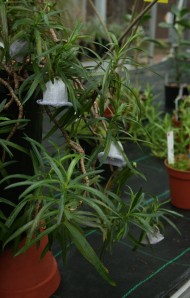
Quite innocent and demure…
At first I thought I was bleeding, but the odd orange color helped me realize it was the nectar from the flower. This is Nesocodon mauritianus, the first ever plant to be discovered to produce red colored nectar. To make things odder it grows on the cliff edges of a waterfall in Mauritius and, though is said to be bird pollinated, it is now thought that it may be gecko pollinated. I guess never judge a book – or in this case a flower – by its cover!

Despite the Dayquil-color, the nectar was pleasantly sweet.
On a different afternoon, but still in the temperate zone, I was chatting with Carlos Magdalena and we wandered around as we showed a few of his plants. We stopped upon his young Puya raimondii plants– a wicked plant that is endemic to the high Andean regions of Peru and Bolivia.

The spines on this pineapple relative is quite vicious – once snagged, it is a rather tender ordeal trying to free yourself.
Being the largest Bromeliad in the world it grows to 6 feet tall and when it is mature (about 40 years) it sends up a flower stalk 3o feet tall covered with thousands of white flowers. Once it blooms and sets millions of seeds, the whole monolithic plant withers away and dies. Crazy – I know.

I find it amazing that this tiny baby Puya raimondii may one day be 36 feet tall.
During another afternoon, Carlos called me over and presented me this plant. Once look and I could hardly believe my eyes, it was Amborella trichopoda! I agree that these are flowers a only a botanist would love, but this is the great, great, great, great, great…great, great, great grandmother of all flowers – the oldest flowering plant that exists on earth today! That is, this plant is one of the surviving relics of the first flowers millions and millions of year ago.

Those tiny things are flowers and they are female.
Amborella is a bit of a unassuming sprawling shrub, but they can only be found in New Caledonia. New Caledonia was far enough from the ravaging poles during the Ice Age that Amborella was untouched by frost and could continue growing. Though this plant is dioecious, oddly they can switch sexes – a ‘male’ plant can produce female flowers and visa versa. Odd, but wonderful!

Like a school dance, the boys and girls are paired off.
In the warmer temperate zone Pavonia bahamensis is blooming. Though the color might not suggest it, but the tubular and nectar rich flowers are made for bird pollinators.

Not as showy as its hibiscus cousins, but it’s packed full of nectar.
Just a few benches over this wonderfully quirky flower belongs to Turraea sericea. The little petaloid ring carrying the anthers reminds me of an Elizabethan neck ruff.

The flower looks very Dr. Seussian.
Just down the corridor in the one of the zones containing Nepenthes lives this almost unbelievable carnivorous plant. Utricularia are carnivorous plants that usually live in ponds and waterways trapping small aquatic arthropods with their bladder-like traps. However this one – Utricularia nelumbifolia – lives in the tanks of bromeliads high up in the jungle canopy of Brazil! I can’t begin to imagine how it evolved this adaptation – just amazing!

If there is a niche, it will be filled.
Passing through the hallway it was hard not to be drawn in by these flashy Pinguicula laueana in flower. This Mexican species of butterwort is pollinated by hummingbirds, hence the bright red flowers.

In person the flowers ranged from shocking red to nearly ultra-violet carmine.
Across the from the temperate carnivorous room is the truly moist tropical zone. This room is quite pleasant with the sultry warmth and humidity enveloping everything. I caught a little glimpse of this Passiflora jussieui beginning to bloom. Though many passion flowers have a nice fragrance, when I bend down for a sniff this one turned out to be quite musky kind of wild-animal-like.

Brown is an unusual color for a passion flower, but I really like it.
In this same room lives the another famous plant: café marron. Ramosmania rodriguesi is a coffee relative native to the island of Rodrigues. This plant was thought to be long extinct, but in 1980 a schoolboy stumbled upon the only plant in existence and cuttings were sent to RBG, Kew.

Here they are enjoying the mist and the early morning sun.
The cuttings were slow to root, but soon they began to grow and eventually reached flowering size. Despite this success the staff ran into one problem: this species was not self-compatible, that is it needed another genetically different individual for successful pollination and all they had were clones.

Though the flowers look like they would be scented, but disappointingly no fragrance to be had.
Long trials of many different methods were tired, but it was finally discovered that hotter temperatures encouraged some female flowers and even though the plants were identical this somehow allowed a loophole for pollination. Though this technique worked it wasn’t a run away success, since the plants were still shy to produce many fruits. Over time the staff kept at pollinating and now they have quite a few plants even enough for the beginnings of reintroductions on the island.

Here’s a female flower – notice the style protruding out of the flower.

Here’s a male flower.
Ramosmania rodriguesi also has a curious adaptation of looking like a completely different plant during its juvenile stage. The leaves start out long and glossy with a pretty pinkish-white midrib that runs down the entire leaf.

Yes, that is still Ramosmania rodriguesi.
Once the plant as reached flowering age it switches from the long, glossy leaves to branches with small oval leaves. If you catch the plant in mid transition, it looks as if to plants were spliced into one.

This juvenile has just reached flowering size and the growth has switched to smaller round leaves.
My final week was a day shorter due to the Easter holiday, but it was packed full of luscious orchids. Are you ready? Here we go!

Labeled as Phalaenopsis schilleriana – which I don’t think it is – isn’t your typical moth orchid.

For some reason the flowers of Renanthera monachica remind me of 80’s parachute pants.

This Chysis bractescens looks like it can bite back. On a side note it faintly smells of jasmine and mothballs.

This Polystachya galeata smelt exactly like a Calvin Klein perfume that a friend always wore during high school.

Lycaste aromatica smells amazingly like the fiery cinnamon candy Red Hots.

I love the little head of light green flowers on Dendrobium capituliflorum.
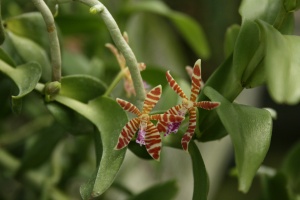
The flowers on Trichoglottis smithii looked like exotic sea stars and it gave off a strong sweet and spicy fragrance.

Here is another Polystachya, specifically Polystachya pubescens. It’s orangey yellow flowers smelt softly of hyacinth and narcissus.

This Oncidium baueri had three flowers spikes that were at least 6 feet long!

The goofy technicolor flowers on Epidendrum pseudepidendrum just screams 80’s.

The flowers on this Epidendrum criniferum reminds me of a giraffe.

These regal purple flowers belong to Dendrobium victoriae-reginae named after Queen Victoria.

An unknown Dendrobium, but the color of a good fried egg.

This little cutie is a Phalaenopsis! Phalaenopsis parishii to be exact.

The springy colors of Dendrobium amabile was perfect for Easter.

The fragrance of Caularthron bicornutum was wonderfully soft and floral, kind of like baby powder with a touch of musk.

This is the wonderfully strange flowers of giant Vandopsis gigantea. I love how the purply-brown buds open to a lovely butter yellow speckled with toffee.

The scent of bumblebee-colored flowers of Dendrobium fimbriatum ranged from just honey with cinnamon to honey with cinnamon and plastic.

I love the earthy spotting on the Ansellia africana flowers.

I love the contrast between the black hairy stem/ovary and the blonde flowers on Paphiopedilum philippinense.

This impressive sight is a bench full of Dendrobium kingianum all blooming together.

This unknown Dendrobium was confiscated at the boarder, masqueraded under the label ‘hybrid’. It’s actually a species and extremely rare and immediately whisked away by one of the botanists for more study.

This Vanda tricolor is apparently the original one from which the species was first described and brought into cultivation – amazing!
On my final day with the Tropical Nursery, I helped the Orchid Department with their display in the Princess of Wales Conservatory. The best orchids in bloom were rounded up and gently carted off to the the glasshouse on the other side of the garden for an Easter display.
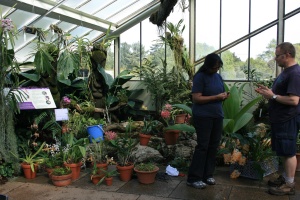
Here are the first batch of orchids waiting to be placed behind glass and out in the beds.
However there was one very special orchid that was to take center stage in the glass cases: Angraeum sesquipedale or Darwin’s Orchid.

It was a special occasion so a photographer came out to take photos for publicity.
A slow growing orchid from Madagascar, this individual decided to throw out four flowering spikes. It was a sight to behold – literally!

Not gonna lie, I wanted to run out the door with it…
Angraecum sesquipedale was discovered in Madagascar in the late 1700’s by a French botanist. Later a flower was sent to Darwin to look at. The white color, fragrance at night, and long nectar rich spur on the back of each flower, Darwin surmised that a moth with a proboscis exactly the length of the spur would be its pollinator. Unfortunately he would not live to see his prediction verified, but 21 years after his death a moth with a proboscis exactly the length of the spur was seen pollinating the orchid.

Being a brittle plant, I was able to exhale once it was placed securely in the glass case.
After the star of the show was safe behind glass, I helped arranged the glass case display in the cool orchid zone.

It was a tight squeeze back there, so I was balancing on my knees most of the time.
Phew! What a long post this time! I started at the Princess of Wales Conservatory today and I will write a post on that towards the end of the week. Until then here are a few photos of the waterlilies in the aquatics zone.

This egg-like blossom was so small and precious.

My camera couldn’t capture the color quite right, but this one was a glowing pink.

There is something so magical about waterlilies rising from the murky depths.

I love how it looks as if each petal was lovingly steeped in blue ink.

This waterlily just took my breath away. I revisited this one many times.
Oh wait! I almost forgot to add earlier that I had the good fortune to meet the world’s smallest waterlily that Carlos famously saved from extinction: Nymphaea thermarum. This waterlily was endemic only to the outflow of a single hot spring in Rwanda, but because the spring was diverted for municipal use it is now extinct in the wild. (The waterlily now only exists at RBG, Kew, except for one that was stolen in January.)

Absolutely adorable!
Okay, that’s it for now. I’ll post post soon!
Tags: Amborella trichopoda, Angraeum sesquipedale, Ansellia africana, Caularthron bicornutum, Chysis bractescens, Dendrobium, Dendrobium amabile, Dendrobium capituliflorum, Dendrobium fimbriatum, Dendrobium kingianum, Dendrobium victoriae-reginae, Epidendrum criniferum, Epidendrum pseudepidendrum, Gerbera jamesonii, Impatiens teitensis, Lycaste aromatica, Nesocodon mauritianus, Nymphaea, Nymphaea thermarum, Oncidium baueri, Paphiopedilum philippinense, Passiflora jussieui, Pavonia bahamensis, Pelargonium appendiculatum, Phalaenopsis parishii, Phalaenopsis schilleriana, Pinguicula laueana, Polystachya galeata, Polystachya pubescens, Princess of Wales Conservatory, Puya raimondii, Ramosmania rodriguesi, Renanthera monachica, Trichoglottis smithii, Trochetiopsis ebenus, Turraea sericea, Utricularia nelumbifolia, Vanda tricolor, Vandopsis gigantea






